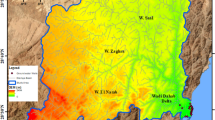Abstract
Natural gas hydrates are known to occur in vast quantities at the ocean floor or in permafrost regions. In-situ hydrate contains great volumes of methane gas, which indicates a potential future energy resource. In this study, we have developed a three-dimensional, multi-phase (gas, water, and hydrate) flow finite-difference model by using implicit pressure explicit saturation technique in order to investigate simultaneous flow through ice-liked hydrate reservoir. The developed model is based on the depressurizing method as producing mechanism. The model evaluates local gas generation dissociated from the hydrate with the aid of kinetic dissociation theory proposed by Kim-Bishnoi. The computation of kinetic dissociation uses the empirical dissociation rate as a function of specific surface area between phases and pressure difference. With the developed model, a one-dimensional system has been simulated for analyzing the production performance of a hydrate reservoir and for investigating the effect of hydrate saturation on absolute permeability and relative permeability characteristics. Also, for the three-dimensional field-scaled reservoir system, a number of numerical exercises have been conducted to understand the effect of mass transfer and to characterize the flowing mechanism under the conditions of increased permeability resulting from the dissociation hydrate.
Similar content being viewed by others
References
Aziz, K. and Settari, A., “Petroleum Reservoir Simulation,” Applied Science Publishers Ltd., London (1979).
Bayles, G. A., Sawyer W. K. and Malone, R. D., “A Steam Cycling Model for Gas Production from a Hydrate Reservoir,”Chem. Eng. Commun.,47, 225 (1986).
Kamath, V. A. and Godbole, S. P., “Evaluation of Hot-Brine Simulation Technique for Gas Production from Natural Gas Hydrates,”JPT, 1379 (1987).
Kim, H. C., Bishnoi, P. R., Heidemann, R. A. and Rizvi, S. S. H., “Kinetics of Methane Hydrate Dissociation,”Chem. Eng., Sci.,42(7), 1645 (1987).
McGuire, P. L., “Methane Hydrate Gas Production by Thermal Stimulation,” Proc. Fourth Canadian Permafrost Conference, H. M. French (ed.), Calgary (1982).
Selim, M. S. and Sloan, E. D., “Hydrate Dissociation in Sediment,”SPERE, 245 (1990).
Sung, W. M., Lee, H. S., Kwon, O. K. and Huh, D. G., “Experimental and Numerical Studies for the Analysis of Equilibrium Conditions of Gas Hydrate,”Geosystem Engineering,1(2), 67 (1998).
Verigin, N. N., Dhabibullin, I. L. and Khalikov, G. A., “Linear Problem of the Dissociation of the Hydrate of a Gas in a Porous Medium,”Izuest, Akad. Nauk. SSR, Mekhanika Gaza,1, 174, (1980).
Yousif, M. H., Li, P. M., Selim, M. S. and Sloan, E. D., “Depressurization of Natural Gas Hydrate in Berea Sandstone Cores,”J. Inclusion Phenomena & Molecular Recognition Chem.,8, 71 (1990).
Yousif, M. H., Abass, H. H., Selim, M. S. and Sloan, E. D., “Experimental and Theoretical Investigation of Methane-Gas-Hydrate Dissociation in Porous Media,”SPERE, 69 (1991).
Author information
Authors and Affiliations
Corresponding author
Rights and permissions
About this article
Cite this article
Sung, WM., Huh, DG., Ryu, BJ. et al. Development and application of gas hydrate reservoir simulator based on depressurizing mechanism. Korean J. Chem. Eng. 17, 344–350 (2000). https://doi.org/10.1007/BF02699051
Received:
Accepted:
Issue Date:
DOI: https://doi.org/10.1007/BF02699051




